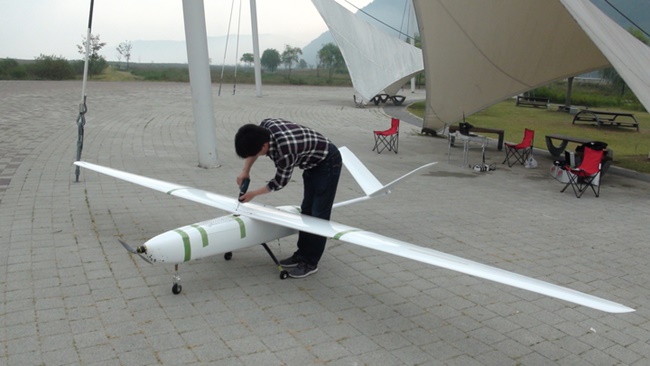
According to the research team led by Professor Yang Cheol-nam at the Korea Institute of Materials Science, the new fuel cell-powered unmanned aerial vehicle flew 310 kilometers for four and a half hours during a recent test, breaking the previous record of one hour and 24 minutes in South Korea. (Image: Korea Institute of Materials Science)
SEOUL, Nov. 7 (Korea Bizwire) – A South Korean research team has developed a hybrid long-flight drone that can stay in the air for up to four and a half hours.
According to the research team led by Professor Yang Cheol-nam at the Korea Institute of Materials Science, the new fuel cell-powered unmanned aerial vehicle flew 310 kilometers for four and a half hours during a recent test, breaking the previous record of one hour and 24 minutes in South Korea.
Previously, South Korean drones weren’t able to stay aloft for long periods of time mainly due to issues with battery weight.
The research team at the Korea Institute of Materials Science then began the development of a new hybrid drone to address the issue, with a focus on making the drone lighter.
In addition, the researchers also developed 600-watt batteries that can survive harsh weather conditions, including temperatures as cold as minus 80 degrees Celsius.
With the combination of a hybrid drone powered by both fuel cells and batteries for a longer flight time, and newly developed batteries, the research team was able to create the new record-breaking drone.
Compared to previous models, the new drone from the Korea Institute of Materials Science’s research team has more effectively tackled the issues of noise and vibration, both of which contribute to a safer and longer flight.
In the wake of the new development, the Korea Institute of Materials Science announced plans to extend the flight time up to 10 hours through gradual steps.
Other plans will see the new fuel cell technology transferred to private research firms including Muin Tech with the goal of commercializing them within the next three years.
The research team is hopeful that up to 1 billion won could be recouped in sales when the technology is commercialized.

A South Korean research team has developed a hybrid long-flight drone that can stay in the air for up to four and a half hours. (Image: Korea Institute of Materials Science)
“We believe the drone’s concealment capability has great potential in the defense industry. It could also be used in the civilian sector for environmental monitoring, keeping an eye on wildfires for instance,” said Yang, who led the research.
Earlier this year, the government announced plans to invest 1.2 trillion won in the drone industry over the next five years to improve technology and infrastructure such as drone highways and test sites.
Ashley Song (ashley@koreabizwire.com)




![[In-depth] K-Dramas and Show Programs Lure Global Viewers [In-depth] K-Dramas and Show Programs Lure Global Viewers](http://koreabizwire.com/wp/wp-content/uploads/2014/10/별에서온그대-370x197.jpg)

